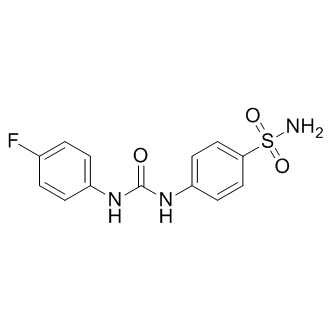| Cas No.: | 178606-66-1 |
| Chemical Name: | NSC-213841; MST-104,U104,U 104 |
| Synonyms: | NSC-213841; MST-104,U104,U 104 |
| SMILES: | C1=CC(=CC=C1NC(=O)NC2=CC=C(C=C2)S(=O)(=O)N)F |
| Formula: | C13H12FN3O3S |
| M.Wt: | 309.32 |
| Sotrage: | 2 years -20°C Powder, 2 weeks 4°C in DMSO, 6 months -80°C in DMSO |
| Description: | U-104 is a potent carbonic anhydrase (CA) inhibitor for CA IX and CA XII with Ki of 45.1 nM and 4.5 nM; low inhibition for CA I and CA II. |
| In Vivo: | U-104 (38 mg/kg) inhibits primary tumor growth in the mice implanted orthotopically with MDA-MB-231 LM2-4Luc+ cells. U-104 (19 mg/kg) inhibits metastases formation in the 4T1 experimental metastasis mice model [1]. U-104 (38 mg/kg) significantly delay primary tumor growth and reduces cancer stem cell population in NOD/SCID mice orthotopically implanted with MDA-MB-231 LM2-4Luc+ cells. U-104 (5 mg/mL, oral gavage) shows a significant delay in tumor growth in Balb/c mice orthotopically implanted with 4T1 cells [2]. |
| In Vitro: | U-104 (50 μM) blocks the mesenchymal phenotype in the cancer stem cells population in hypoxia condition of 4T1 cells. U-104 (<50 μM) significantly reduces migration in a dose-dependent manner in metastatic MDA-MB-231 LM2-4Luc+ cells , with cells growing as compact colonies similar to parental MDA-MB-231 cells [2]. |

 DC Chemicals' products qualify for U.S. tariff exemptions. We guarantee no price increases due to customs duties and maintain stable supply, continuing to deliver reliable research solutions to our American clients.
DC Chemicals' products qualify for U.S. tariff exemptions. We guarantee no price increases due to customs duties and maintain stable supply, continuing to deliver reliable research solutions to our American clients.





















